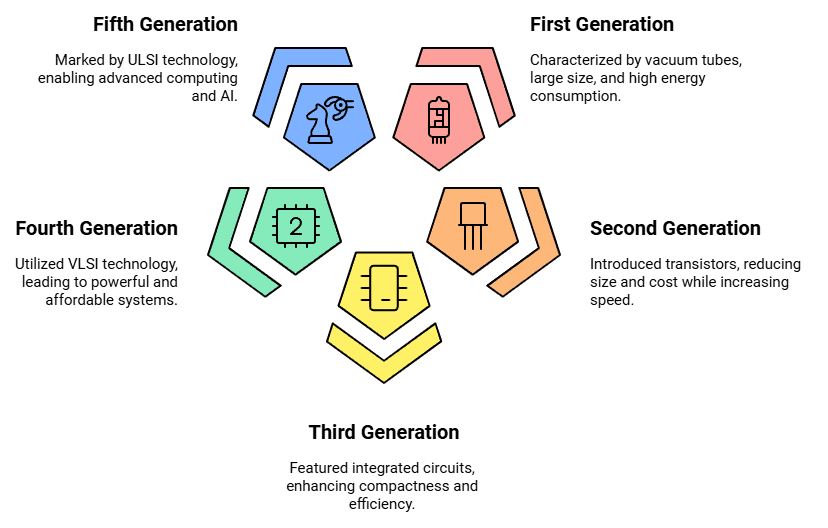UPSC Exam > UPSC Notes > Famous Books for UPSC Exam (Summary & Tests) > Generations of Computer - Computer Fundamentals, Computer Awareness
Generations of Computer - Computer Fundamentals, Computer Awareness | Famous Books for UPSC Exam (Summary & Tests) PDF Download
Generations of Computer
The ancient computers occupied more space and more infrastructure. So it took up-gradations through 5 generations to become the modern day computer.
The generations of computer are discussed below as follows:
First Generation Computer
- Period : 1946-1959.
- They used Vacuum tubes as their basic component.
- They produced more heat, so needed cooling devices.
- They consumed huge electricity, occupied huge spaces, huge costs, etc.,
- Machine code was used as programming language.
- Example : ENIAC
Second Generation Computer
- Period : 1959-1965.
- They used transistors as their components as they were cheap, compact, faster programming and produced less heat than the first generation computers.
- Assembly language and high-level programming languages like FORTRAN, COBOL was used.
- Example : UNIVAC 1108
Question for Generations of Computer - Computer Fundamentals, Computer AwarenessTry yourself:Which component was used in the first generation of computers?
View Solution
Third Generation Computer
- Period : 1965-1971.
- They used Integrated circuits instead of transistors.
- An Integrated Circuit consists of many transistors, resistors and capacitors along with the associated circuitry.
- The Integrated circuit was invented by Jack Kilby.
- It provided compactness, cost effectiveness, less electricity consumption, etc.,
- High-level languages like FORTRAN-II TO IV, COBOL, PASCAL PL/1, BASIC, ALGOL-68 were used.
- Example : Honeywell-6000 series
Fourth Generation Computer
- Period : 1971-1980.
- They used Very Large Scale Integrated (VLSI) circuits instead of Integrated circuits.
- VLSI had the capability to have numerous transistors and other circuitry on a single chip.
- It still paved way for compactness, no requirement of cooling AC unit, affordable, powerful, etc.,
- High-level languages like C, C++, DBASE etc., can be used.
- Example : STAR 1000
Fifth Generation Computer
- Period : 1980-present times.
- The VLSI technology was transformed into ULSI (Ultra Large Scale Integration) technology accommodating millions of electronic components in a chip.
- It provided way for artificial intelligence and created more powerful, compact, affordable, advanced computers.
- All high-level languages like C and C++, Java, .Net etc. can be used.
- Example : Laptops
The document Generations of Computer - Computer Fundamentals, Computer Awareness | Famous Books for UPSC Exam (Summary & Tests) is a part of the UPSC Course Famous Books for UPSC Exam (Summary & Tests).
All you need of UPSC at this link: UPSC
|
744 videos|1444 docs|633 tests
|
FAQs on Generations of Computer - Computer Fundamentals, Computer Awareness - Famous Books for UPSC Exam (Summary & Tests)
| 1. What are the characteristics of first-generation computers? |  |
Ans. First-generation computers were characterized by the use of vacuum tubes for circuitry, large size, high power consumption, and limited programming capabilities.
| 2. What are some examples of first-generation computers? |  |
Ans. Some examples of first-generation computers include the ENIAC, UNIVAC I, and IBM 701.
| 3. How did the second generation of computers differ from the first generation? |  |
Ans. The second generation of computers used transistors instead of vacuum tubes, resulting in smaller size, lower power consumption, faster processing speeds, and improved reliability.
| 4. What advancements in technology were made during the second generation of computers? |  |
Ans. During the second generation of computers, advancements were made in the development of magnetic core memory, high-level programming languages, and the introduction of batch processing.
| 5. How did the development of third-generation computers improve upon earlier generations? |  |
Ans. Third-generation computers featured the use of integrated circuits, which allowed for even smaller size, lower cost, and increased processing power compared to previous generations.
Related Searches

















